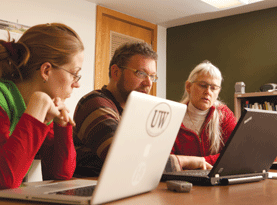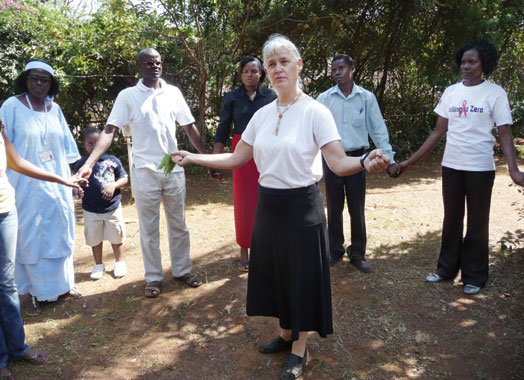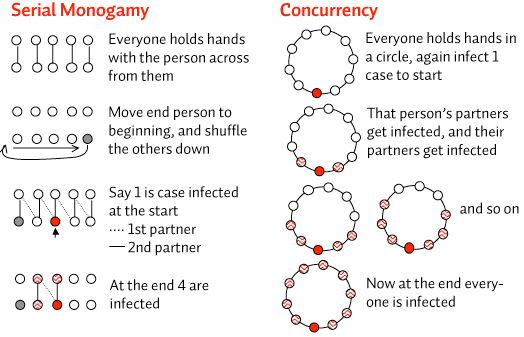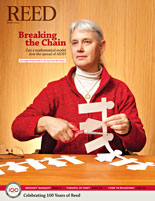
IRIS login | Reed College home Volume 91, No. 1: March 2012
Breaking the Chain (continued)
![]()
Reasons behind the vehemence of the attacks are difficult to pinpoint. One possibility, both Morris and Epstein suggest, is the rise of quantitative purists in the social and health sciences who insist on unrealistically precise data to plug into their increasingly powerful computer models. Another is concerns about moralizing to African audiences, sensitive after a long history of racial stereotyping dating back to the colonial-era missionaries. Still another is the self-serving behavior of Western scientists and aid agencies to find and trumpet data supporting work that’s most likely to be funded, including intervention programs focused on abstinence and condom usage.

Number cruncher Martina Morris ’80 works with colleagues at the University of Washington.
Photo by Hayley Young
Even while arguments continue among PhDs in the West, African governments and nonprofits have for years embraced the idea that concurrent partnerships pose real risk. And they’re trying to do something about it.
Reducing concurrent partnerships was identified as the number one priority for prevention at a 2006 meeting of the South African Development Community, which encompasses 15 member countries. Since then, various Africa-based public health information campaigns, relying on everything from traveling skits and billboards to Facebook and YouTube, have been making waves across the continent.
One example comes from the Uganda Health Marketing Group. Staffed by Ugandan public relations professionals and supported by the U.S. Agency for International Development, the organization won a series of awards in 2010 for its campaign titled “One Love—Get off the Sexual Network.” The goal: increase serial monogamy among the population by 5% by warning about the dangers of “side dishes” in relationships.
The campaign is blunt. In a January 2010 column for the Observer, an independent weekly newspaper based in Kampala, journalist Simon Kasyate wrote, “[T]his ‘sexual network’ campaign is really sending heavier jabs below the belt than initially anticipated. ‘Man, they have skits you don’t want to listen to when driving with your wife,’ a colleague said recently. ‘The guilt of the realism in the message makes you almost break down in confession.’”
Morris didn’t advise the campaign but says that in general she has been “remarkably impressed” by the locally planned and managed interventions focused on concurrency that have sprung up around sub-Saharan Africa, where the AIDS crisis remains widespread.
In Kenya, where Morris is currently working on a small intervention and research project, AIDS deaths still number close to 100,000 per year, according to UNAIDS. In contrast, AIDS deaths in the United States, which has a population more than seven times that of Kenya’s, number less than 25,000.
Despite the staggering nature of numbers like these, and the difficulty of working halfway around the globe, Morris says there’s a strong sense of hope for the continent’s future among local Africans with whom she works. So, several times a year, she makes the arduous 24-hour flight from Seattle through Amsterdam to a major African city. In January 2012, that city was Nairobi, Kenya, home of one of her current collaborators, Kawango Agot.
“Martina is out in the field with us,” says Agot, director of Impact Research and Development Organization, a Kenyan NGO that develops public health programs aimed at the country’s vulnerable populations. “She spends the day drinking tea with women in villages, eating boiled maize, helping us push our vehicle when it gets stuck in the mud, and walking long distances when the roads become impassable. Then, when we get back to the office at night, she pulls out her laptop and works on these complex statistics.”
Those statistics seem likely to be a bone of contention among Western scientists for years to come. But perhaps not among everyday Africans. Evidence of this came on a recent Kenyan trip, when Morris had another memorable exchange with a local man with strong opinions about her work.
During a focus group to plan an intervention campaign, Morris was attempting to explain the risks of concurrency by having people stand in a circle and hold hands. Each person, she noted, is linked to just two people, but the entire room is connected.
In the middle of her explanation, one of the older men in the community stood up and asked to speak.
“This is the medicine we’ve been waiting for,” he said.
Can the Circle Be Unbroken?

 To explain how concurrency affects the spread of HIV, Morris, an accomplished dancer, often choreographs a simple exercise that requires the audience to get up and move around. First, she asks everyone to pick one partner, and hold hands for a moment. She then instructs everyone to let go and find another person with whom to hold hands. That’s akin to serial monogamy; by the end of the cycle, four individuals (the original vector, their current partner, their previous partner, and their previous partner’s current partner) were exposed to the virus. To demonstrate the risks of concurrency she asks the group stand in a big circle and hold hands. No individual has more than two partners, but it’s immediately obvious that the virus is no longer confined to a single partnership; the entire group is connected, and everyone is now vulnerable to infection from anywhere in the network. While Morris’s models rely on heavy doses of statistical analysis and computer coding, these hand-holding exercises have proven effective in a host of contexts, from a recent lecture at Reed to talks in remote Kenyan villages. “Really, this is just a classic sociological concept,” she says. “The whole is greater than the sum of the parts.” —GK
To explain how concurrency affects the spread of HIV, Morris, an accomplished dancer, often choreographs a simple exercise that requires the audience to get up and move around. First, she asks everyone to pick one partner, and hold hands for a moment. She then instructs everyone to let go and find another person with whom to hold hands. That’s akin to serial monogamy; by the end of the cycle, four individuals (the original vector, their current partner, their previous partner, and their previous partner’s current partner) were exposed to the virus. To demonstrate the risks of concurrency she asks the group stand in a big circle and hold hands. No individual has more than two partners, but it’s immediately obvious that the virus is no longer confined to a single partnership; the entire group is connected, and everyone is now vulnerable to infection from anywhere in the network. While Morris’s models rely on heavy doses of statistical analysis and computer coding, these hand-holding exercises have proven effective in a host of contexts, from a recent lecture at Reed to talks in remote Kenyan villages. “Really, this is just a classic sociological concept,” she says. “The whole is greater than the sum of the parts.” —GK
GO FURTHER
Watch an animated simulation of how concurrency accelerates HIV
Video of Morris at a 2011 World Bank debate on concurrency
Get Off the Sexual Network. AIDS prevention ad for Uganda TV
The Side Dish Issue. P. Bakibinga. BBC World Service. Apr. 30, 2011.
“Sexual network ad grating on nerves,” by S. Kasyate. The Observer. Jan. 24, 2010.
- Previous Page
- 1
- 2
- 3
- Next Page


LATEST COMMENTS
steve-jobs-1976 I knew Steve Jobs when he was on the second floor of Quincy. (Fall...
Utnapishtim - 2 weeks ago
Prof. Mason Drukman [political science 1964–70] This is gold, pure gold. God bless, Prof. Drukman.
puredog - 1 month ago
virginia-davis-1965 Such a good friend & compatriot in the day of Satyricon...
czarchasm - 4 months ago
John Peara Baba 1990 John died of a broken heart from losing his mom and then his...
kodachrome - 7 months ago
Carol Sawyer 1962 Who wrote this obit? I'm writing something about Carol Sawyer...
MsLaurie Pepper - 8 months ago
William W. Wissman MAT 1969 ...and THREE sisters. Sabra, the oldest, Mary, the middle, and...
riclf - 10 months ago